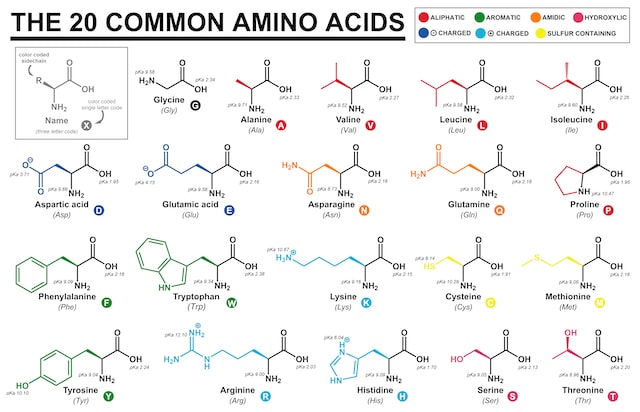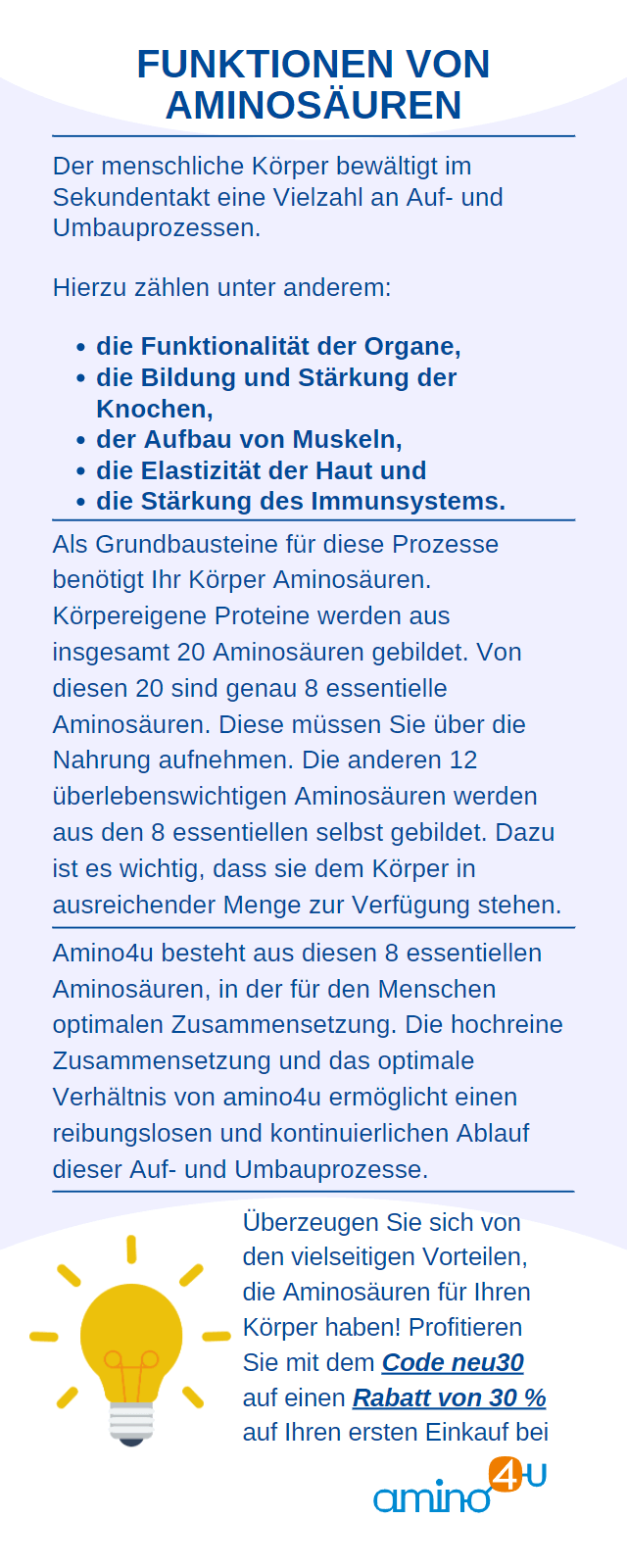Amino acids can be divided into various categories. Do you know essential amino acids and non-essential amino acids ? This distinction is based on which amino our body produces itself and which it does not. In addition, the protein building blocks can be classified according to their chemical properties. In the following article you will find out what constitutes acidic and basic amino acids.
The properties of acidic and basic protein building blocks
Aminos that are used to build the body's own protein are called
proteinogenic amino acids . We often call them
amino acids proteins . These aminos are of great importance because they form the human genetic code. The protein building blocks can differ in their
chemical-physical properties .
Some of them are acidic , others basic. This affects, among other things, the influence the respective amino can have on certain metabolic processes. Both
acidic and alkaline components are important for our health. It's all about balance.

The pH value and the neutral blood
The
pH value is a measure of whether an aqueous solution is acidic or basic. The value 7 is neutral.
Values below 7 represent acids, values above 7 represent bases . The pH of human blood is around 7. Blood has a neutral pH. Stomach acid has a pH value of 2. Urine in healthy people has a value between 5 and 7. Saliva is also normally neutral and has a maximum pH of 7.1.
If the normal pH values in different areas of the body deviate from the normal pH values, health problems can arise.
In the organism, environments with chemical-physical properties are provided for certain metabolic processes. For example, if the
gastric juice loses its acidic character , digestive difficulties can occur because the food is no longer broken down appropriately. Our body is predominantly at a basic to neutral level.

The acid-base balance
The acid-base balance is a complex regulatory system that is intended to counteract imbalances in pH values. The blood, connective tissue, kidneys and lungs are particularly integrated into this system. Various external influences, for example through
the intake of food, affect this regulatory system and can cause acidic conditions in the body.
If the system is overwhelmed, some nutritionists and naturopaths see the risk of the organism becoming too acidic. They assume that our diet in particular could overload the buffer systems of the regulatory organs.
Protein and some aminos can form acids when broken down and metabolized. Other protein building blocks can in turn contribute to the balance between acids and bases.
Every amino acid has its place and its area of responsibility , regardless of whether it is acidic or basic. Problems can arise when individual building blocks are missing or certain aminos and other substances predominate.
Acidic amino acids
Most protein building blocks cannot be clearly described as basic or acidic. This is due to their chemical structure. They
each have an acidic component and a basic component . However, certain proteinogenic building blocks still form a lateral line in their structure, which gives them an acidic or basic character. You can take advantage of their specific properties in a balanced and conscious diet.
Acidic amino acids: aspartic acid and glutamic acid
These protein building blocks already have their acidic character in their name. They react chemically as acid and in this reaction they become the salts aspartate and glutamate. Both are neurotransmitters. These are messenger substances that promote or prevent certain reactions in the
human nervous system . In addition, both building blocks are needed to build the body's own protein.
Acidic amino acids: aspartic acid - aspartate
This amino is found in various foods such as
cod, tofu, soy and egg whites . The building block is said to work together with
glutamate as a messenger in the majority of synapses in the human nervous system. The synapses form the connections between different nerve cells.
The protein building block also has a function in the urea cycle. The urea cycle is an important metabolic process. It is also interesting that aspartic acid is the basis for the production of aspartatame. Aspartatame is a well-known, but not without controversy, sweetener.
Acidic amino acids: glutamic acid and glutamate
Glutamic acid is found in various foods such as
beef, chicken, salmon, chicken eggs and cow's milk . As a messenger substance, glutamate performs an exciting (activating) function. This neurotransmitter is also active in the retina of the eyes. It promotes muscle building and is said to support the immune system.
As a food additive, glutamate has a flavor-enhancing effect .

Lysine, histidine and arginine
This group of three forms the basic representatives of the protein building blocks. Lysine is also an essential amino acid. It is not produced by the organism itself, but must be continually supplied with food. Arginine and histidine are semi-essential protein building blocks.
Lysine
Lysine has a variety of functions in the body. If
rapid muscle building is your goal, lysine can provide you with the energy you need.
The protein building block is, among other things
- in the construction of other protein building blocks,
- on bone growth,
- in cell division and
- wound healing
involved. It is particularly interesting because it builds collagen. Collagen is a special form of tissue that forms the basis of connective tissue. Lysine is mainly found in foods of animal origin such as meat, eggs, fish or dairy products.
There is evidence
that lysine can help keep herpes viruses at bay. The viruses of the herpes family rest in the nerve cells after a person has been infected with them. Under certain circumstances and due to certain factors they can become active again. Then, among other things, the typical herpes blisters can appear on the lip, for example.
Whether lysine can actually inhibit the reactivation of herpes viruses has not yet been scientifically proven. However, it seems possible that there is an interaction with the other
basic amino acid arginine . Arginine and lysine occupy similar receptors in the human nervous system. Although the exact connections with arginine are not yet known, arginine is said to promote the activation of herpes viruses.
Arginine
Arginine has many vital functions. Among other things, it is involved in nitrogen metabolism.
Nitrogen metabolism is an important system on which, among other things, the condition of the blood vessels depends.
Arginine has a vasodilating function . Various dietary supplements and even medicines also take advantage of this effect. Arginine is said to be used for erectile dysfunction and can lower blood pressure. Final research results are still pending in this area. Bodybuilders also like to take advantage of the pumping effect of arginine.
Studies have also shown that arginine has an antioxidant effect.
Antioxidants fight so-called free radicals in our body . These are oxygen molecules that readily bind. They can have a cell-damaging effect and are thought to be responsible for many negative phenomena such as wrinkles.
histidine
Histidine is the precursor to various other important substances such as histamine. Histamine, in turn, has an important function in the human immune system. Histidine also plays a
role in blood formation via the blood pigment
hemoglobin and the incorporation of iron into this process.

Every amino acid has its place
When comparing the
different protein building blocks , it would be wrong to say that the acidic representatives are less important or even harmful. All aminos presented here have an important function and play an important role in the balance of the protein building blocks.
It is noticeable that the acidic aminos form salts such as glutamate and aspartate. Some nutrition experts view their additional intake in excess. Examples include the sweetener aspartate and the use of glutamate as a flavor enhancer. A
very high concentration of these acids is created here, which may not be available to all people. However, if these aminos are absorbed together with other building blocks, they carry out their normal functions in various metabolic processes.
When it comes to basic aminos, some of them, like
arginine, can also be used as solo dietary supplements . Not all effects have been scientifically substantiated, but many people already benefit from additional intake. With all amino acids as well as the balance between acids and bases, you should note that
the interaction of all amino acids is important . If you consume more arginine, you shouldn't forget lysine.







